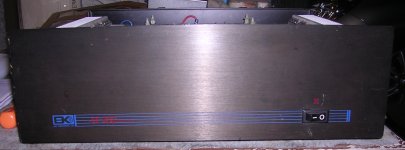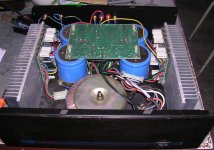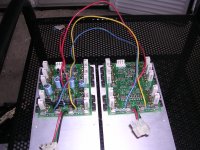Have you had any luck? I've been looking too. Mine have been in service since early 1993 and it's time to think about renewing capacitors and preparing for any upcoming issues.
I did have a brief exchange with the service center that the "new B&K" sends you to for service on these old products. I was asking about updates, running changes, known service issues, and the possibility of retrofitting balanced inputs in place of the RCA connectors. The guy that responded was kind of rude and careless in his reply. He appeared to be more interested in selling me freaking $300 power cords than answering the questions. It wasn't a promising exchange, to say the least.
I did have a brief exchange with the service center that the "new B&K" sends you to for service on these old products. I was asking about updates, running changes, known service issues, and the possibility of retrofitting balanced inputs in place of the RCA connectors. The guy that responded was kind of rude and careless in his reply. He appeared to be more interested in selling me freaking $300 power cords than answering the questions. It wasn't a promising exchange, to say the least.
No, got the same response from the B&K people. It seems nobody has the schematic. I do remember seeing one M200 amp with the cover off and there was an schematic printed on the cover or somewhere inside. I don't remember if it had the component values though. I was considering buying a pair once but since there is no service info I lost interest.
See the benefit of self made amp? You never are looking for the drawing=)
-The guy that responded was kind of rude and careless in his reply. He appeared to be more interested in selling me freaking $300 power cords than answering the questions.
That is how we run businesses today after huge generation of "accounts" have become in charge of manufacture and service. Have the same situation at place where I work. What a people. What a world =)
-The guy that responded was kind of rude and careless in his reply. He appeared to be more interested in selling me freaking $300 power cords than answering the questions.
That is how we run businesses today after huge generation of "accounts" have become in charge of manufacture and service. Have the same situation at place where I work. What a people. What a world =)
Thank you for the pointer to the manuals. Unfortunately, those are user manuals and more unfortunately, do not include the M-200. The user manual for the M-200 is four pages, I think, most of it boilerplate. It lists the specs for the amp and points to the single RCA input connector, the power cord, the on-off switch, and the binding posts for the speaker. That's all there is to it.
So we're all still looking for the schematic.
Anyway, I opened one of them up. OMG. "Crude" about sums it up. I was kind of shocked by the sloppy-looking wiring and tack soldering in too many places. For something that sold for as much as these did, they should have been more professional. The signal-level board was borrowed from a stereo amp, and only half of it is populated.
The real reason for opening it up though was to look at the power supply caps. There are FOUR 15,500@75V Philips (NLA) 3"x4.125" Computer Grade caps with a 1989 date code. (That's one place the money went....) Nearest replacement I found at a reasonable price is a CDE CGS173U075X4C at $38 at Newark. Most other places have it from $55-$75, so this is a pretty good deal. There are remarkably few electrolytics in there -- the only other ones I saw were two 100/100 radial lead, and two other small ones that were something like 10/25 or thereabouts. I had trouble reading those, and knew I had new ones close in value in stock already so I wasn't too concerned. Also unexpected was the lack of bypass caps on the power modules. Without extensive disassembly, I was able to see only two small dipped caps, without any visible markings. Could have been dipped tantalums or maybe mica. Hard to say.
But the worst was yet to come. On unscrewing the signal-level board, I discovered a horrendous assembly practice -- the board, which extends across the full width of the amp, was screwed onto the cap terminals by the usual screws and internal-tooth lockwashers. They torqued-down on those screws so hard that the toothed washers chewed RIGHT THROUGH THE BOARD'S COPPER! Two of the connections were biting down on nothing but chewed-up FRP. OMG. It was one of the worst things I've ever seen in a commercial product, and whoever cooked-up this assembly technique should be banished from the business permanently.
Anyway, I've ordered new caps and will take corrective measures with the connections when I install them.
What I find remarkable is how well these amps work despite the amateur-hour build quality.
I'd be interested to hear about other owner's experiences with them.
So we're all still looking for the schematic.
Anyway, I opened one of them up. OMG. "Crude" about sums it up. I was kind of shocked by the sloppy-looking wiring and tack soldering in too many places. For something that sold for as much as these did, they should have been more professional. The signal-level board was borrowed from a stereo amp, and only half of it is populated.
The real reason for opening it up though was to look at the power supply caps. There are FOUR 15,500@75V Philips (NLA) 3"x4.125" Computer Grade caps with a 1989 date code. (That's one place the money went....) Nearest replacement I found at a reasonable price is a CDE CGS173U075X4C at $38 at Newark. Most other places have it from $55-$75, so this is a pretty good deal. There are remarkably few electrolytics in there -- the only other ones I saw were two 100/100 radial lead, and two other small ones that were something like 10/25 or thereabouts. I had trouble reading those, and knew I had new ones close in value in stock already so I wasn't too concerned. Also unexpected was the lack of bypass caps on the power modules. Without extensive disassembly, I was able to see only two small dipped caps, without any visible markings. Could have been dipped tantalums or maybe mica. Hard to say.
But the worst was yet to come. On unscrewing the signal-level board, I discovered a horrendous assembly practice -- the board, which extends across the full width of the amp, was screwed onto the cap terminals by the usual screws and internal-tooth lockwashers. They torqued-down on those screws so hard that the toothed washers chewed RIGHT THROUGH THE BOARD'S COPPER! Two of the connections were biting down on nothing but chewed-up FRP. OMG. It was one of the worst things I've ever seen in a commercial product, and whoever cooked-up this assembly technique should be banished from the business permanently.
Anyway, I've ordered new caps and will take corrective measures with the connections when I install them.
What I find remarkable is how well these amps work despite the amateur-hour build quality.
I'd be interested to hear about other owner's experiences with them.
By the way, there's another alternative -- 15,000 at 100V, CDE CGS153U100X4C that Sager has (they have over 300 of them which probably explains the good price) for $30. You can see that here: http://www.sager.com/cgs153u100x4c-355526.html The Honey Badger builders might also like these to avoid those crappy snap-in caps that don't last more than six or seven years.
At the 123VAC line here, the caps have 72.2VDC on them, so either of these would be okay.
At the 123VAC line here, the caps have 72.2VDC on them, so either of these would be okay.
Thanks, Lawnmower1! I'll be dusting off my M200's and going through them in the next few months as I re-build our home theater set up. I've had them mothballed for years, as the last time I used them they began making odd capacitor noises, so I put them away before damaging anything. BTW those CDE CGS153U100X4C that Sager has are now $75.00 (+-), so that's a bit of a bummer. Have you delved any deeper since your last post? Thanks in advance!
This is my model of B&K M200
Hi,
As I know there are many models of B&K M200, here are pictures of my amp, are you talking about this model or another one? On my amp output pairs are K1058/J162 and I also noticed that one card is half populated. Only output stage is used may be ? (in // with the fully populated card card).
I took it apart because one of them has a problem. Are pictures of your amps available?
Hi,
As I know there are many models of B&K M200, here are pictures of my amp, are you talking about this model or another one? On my amp output pairs are K1058/J162 and I also noticed that one card is half populated. Only output stage is used may be ? (in // with the fully populated card card).
I took it apart because one of them has a problem. Are pictures of your amps available?
Attachments
I know this is an old post but has anyone found a schematic for these amps? I just purchased a pair of mono amps and looking to refresh these. It's hard to do with the wiring the way it is currently. I'd just like to make sure all is there.
BK Components EX-442 - Manual - Stereo Power Amplifier - HiFi Engine
The notes clearly state that the schematic is also for the M200 and explains the differences, they are few.
- Status
- This old topic is closed. If you want to reopen this topic, contact a moderator using the "Report Post" button.
- Home
- Amplifiers
- Solid State
- B&K M200 Monoblock Schematic


